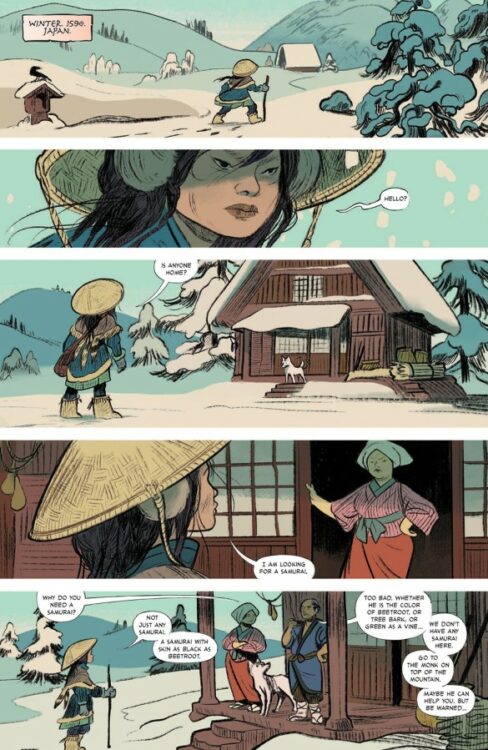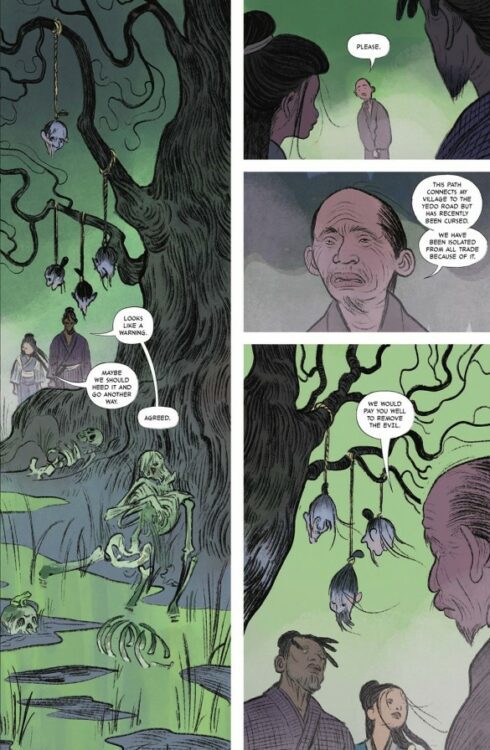From writer HS Tak (Redshift; BOY-1) and artist Isabella Mazzanti comes the best samurai comic of the last 10 years with Hitomi. Featuring layouts from Nicoletta Bea, colors by Valentina Napolitano, and lettering by Rob Jones, this 5-issue mini-series about a young girl seeking vengeance on an old ronin far from his homeland is the greatest comic of its kind since Inoue’s Vagabond. With intelligent and poetic scripts and staggering visual work, Hitomi is one of the best comics of the past year and a must-read for fans of the genre.
“In Feudal-era Japan, a drifter with no prospects begins training in secret under Yasuke, a once-famous and now-disgraced warrior, as she struggles to find her place in a society entrenched in discrimination and violence. Combining the historical sweep and elegance of Kurosawa with the visceral action of Tarantino, this saga follows the trials and tribulations of a young female warrior who travels the country-side unendingly working to gain the rank of Samurai, a title no man, monster, or myth can give to her, but one that she will have to take.”
Writing & Plot
HS Tak mixes the classic tropes of a great revenge story with both wisdom and incisive political underpinnings in Hitomi. A young woman whose family was killed when she was young begins a journey to find and kill the samurai responsible for making her an orphan. That samurai? None other than Yasuke, the legendary African samurai of the 16th century. Yasuke has since become a ronin, giving up the blade and now only seeking passage back to his homeland. The girl manages to convince Yasuke to become her teacher (he doesn’t know who she is) with aims to betray him later, and that’s where our main story begins. Tak goes to great lengths to sow the general disregard the samurai have for regular people – and the internal class struggles that come with that. The comic has a slightly episodic structure, with each issue continuing the overall plot but having a distinct scenario that helps paint a larger picture of this setting. From being threatened for execution for stealing a small bottle of sake, to witnessing an entire culture of violent abuse towards women, Tak never takes his foot off the gas to show that the honor-focused way of the samurai is often grossly over-romanticized. Both of our protagonists in Yasuke and the angry young woman are unique, compelling characters with great arcs. Their flaws – the girl’s rash nature and Yasuke’s constant hesitation – make them feel more real. The rest of the cast is made up of memorable faces as well, as a variety of folks help or hinder the pair along their path. Tak’s dialogue is sharp and full of wit, with surprise hits of what feels like period accurate poetry. Tak makes his influences known for this mini-series, but keeps the entire experience feeling fresh. Hitomi has a sense of age and wisdom in the comic, as though it were a tale crafted during Japan’s feudal era – that’s just the magic Tak brings to the table.
MFR ON YOUTUBE (latest video)
Help us reach 5K Subs!
Art Direction
Hitomi has the benefit of not only having a smart and timeless-feeling script, but the visual experience to match its story. Penciler Isabella Mazzanti and color artist Valentina Napolitano have created an art style that is as timeless as the book’s storytelling conventions. The pair of artists intentionally aim for a style that reimagines period-correct emakimono scroll paintings that bring the reader right into the setting. Mazzanti’s thin lines and attention to historical detail bring the pages to life with one of the most impressive representations of a realistic setting in recent comics. Her sequencing is also stellar, with the whole issue feeling well-balanced and expertly paced. There are some sequences that break panel structure, with borderless images stacked on top of each other. Every page has a spread or panel that is worthy of being in a gallery – or at least as a desktop background. Napolitano’s flat-style colors bring home the 16th century feel of this comic, with her tones having that scroll-printed appearance that makes this issue like nothing else on shelves today. The lettering from Rob Jones has a classical hand drawn look that matches the comic perfectly. His SFX work has a very distinct approach as well, with a sort of minimalist but noticeable punctuation of sound in each panel where he uses it. Overall, Hitomi is a stunning comic mini-series and an excellent representation of traditional Japanese styled art in a Western comic.
Verdict
Hitomi is a brilliant story of vengeance and political history from the eyes of regular people under the rule of the samurai. HS Tak pens scripts full of poetic wisdom, clever humor, and poignant storytelling to create an entertaining yet thoughtful story set in 16th century Japan. The visuals from Isabella Mazzanti and Valentina Napolitano look as though they were ripped right out of the time period they portray, but with a modern comic book-style creative approach that makes Hitomi one of the most unique comics in recent memory. This is a must-read for fans of samurai stories and revenge tales as a whole.

